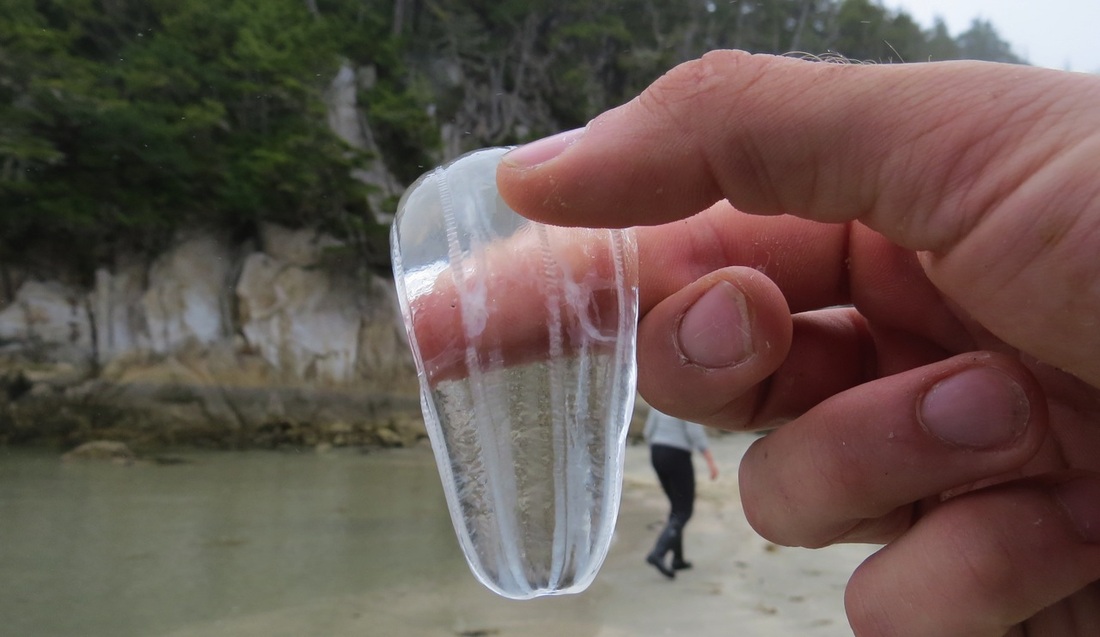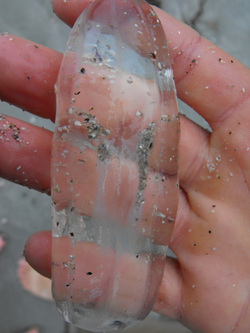Lobed comb jelly, lobed sea gooseberry • Bolinopsis infundibulum
This lobed comb jelly was found washed up on shore. Photos by Arden Mathieson (left) and Matthew Morrison.
Identification
This jelly has an elongated oval shape and gets up to 15 cm long. Its body is transparent and somewhat pear-shaped. It is known as a lobate ctenophore, meaning has two large lobes near its mouth (oral end, at the "front" while swimming). The lobed comb jelly has eight rows of cilia that are unequal in length and display a rainbow of colors. These rainbow cilia are most on display in dark surroundings.
Habitat and Range
The lobed comb jelly lives in pelagic waters to a depth of 1000 meters, with the largest individuals found deepest. This species is often seen when it washes up on shore. Its known range extends from the Arctic to the Mediterranean in European waters, and from the Bering Sea to California in the Pacific Northwest.
Similar Species
The similar orange-tipped sea gooseberry (Leucotheca pulchra) is covered in small orange spots and is about twice the size of the lobed comb jelly. B. infundibulum may also be confused with the warty comb jelly (Mnemiopsis leidyi), however this species is native to the Atlantic Ocean and invasive in other waters, though it has not yet been reported in the Pacific. Other comb jellies found in Pacific Northwest waters are the cat's eye comb jelly (Pleurobrachia bachei), the oval sea gooseberry (Euplokamis dunlapae), and translucent comb jellies (Beroe spp.)
Intriguing Information
Each individual is both male and female. The distinctive front lobes open to consume drifting prey. Comb jellies use sticky cells on their tentacles to capture prey.
iNaturalist
https://www.inaturalist.org/taxa/492705-Bolinopsis-infundibulum
This jelly has an elongated oval shape and gets up to 15 cm long. Its body is transparent and somewhat pear-shaped. It is known as a lobate ctenophore, meaning has two large lobes near its mouth (oral end, at the "front" while swimming). The lobed comb jelly has eight rows of cilia that are unequal in length and display a rainbow of colors. These rainbow cilia are most on display in dark surroundings.
Habitat and Range
The lobed comb jelly lives in pelagic waters to a depth of 1000 meters, with the largest individuals found deepest. This species is often seen when it washes up on shore. Its known range extends from the Arctic to the Mediterranean in European waters, and from the Bering Sea to California in the Pacific Northwest.
Similar Species
The similar orange-tipped sea gooseberry (Leucotheca pulchra) is covered in small orange spots and is about twice the size of the lobed comb jelly. B. infundibulum may also be confused with the warty comb jelly (Mnemiopsis leidyi), however this species is native to the Atlantic Ocean and invasive in other waters, though it has not yet been reported in the Pacific. Other comb jellies found in Pacific Northwest waters are the cat's eye comb jelly (Pleurobrachia bachei), the oval sea gooseberry (Euplokamis dunlapae), and translucent comb jellies (Beroe spp.)
Intriguing Information
Each individual is both male and female. The distinctive front lobes open to consume drifting prey. Comb jellies use sticky cells on their tentacles to capture prey.
iNaturalist
https://www.inaturalist.org/taxa/492705-Bolinopsis-infundibulum
References
Harbo, R. (2011). Whelks to Whales (2nd ed.). Maderia Park: Harbour Publishing. Pp. 70-71.
Lamb, A., & Hanby, B. (2005). Marine Life of the Pacific Northwest. Madeia: Harbour Publishing. P. 135.
Nagabhushanam, A. K. (1959). Feeding of a ctenophore, Bolinopsis infundibulum (O. F. müller). Nature, 184(4689), 829-829. doi:10.1038/184829a0
Sept, D. (2009). The Beachcombers Guide to Seashore Life in the Pacific Northwest, Revised. Maderia Park: Harbour Publishing. P. 32.
Authors and editors of page
Arden Mathieson, Kelly Fretwell, and Brian Starzomski (2014).
Harbo, R. (2011). Whelks to Whales (2nd ed.). Maderia Park: Harbour Publishing. Pp. 70-71.
Lamb, A., & Hanby, B. (2005). Marine Life of the Pacific Northwest. Madeia: Harbour Publishing. P. 135.
Nagabhushanam, A. K. (1959). Feeding of a ctenophore, Bolinopsis infundibulum (O. F. müller). Nature, 184(4689), 829-829. doi:10.1038/184829a0
Sept, D. (2009). The Beachcombers Guide to Seashore Life in the Pacific Northwest, Revised. Maderia Park: Harbour Publishing. P. 32.
Authors and editors of page
Arden Mathieson, Kelly Fretwell, and Brian Starzomski (2014).






